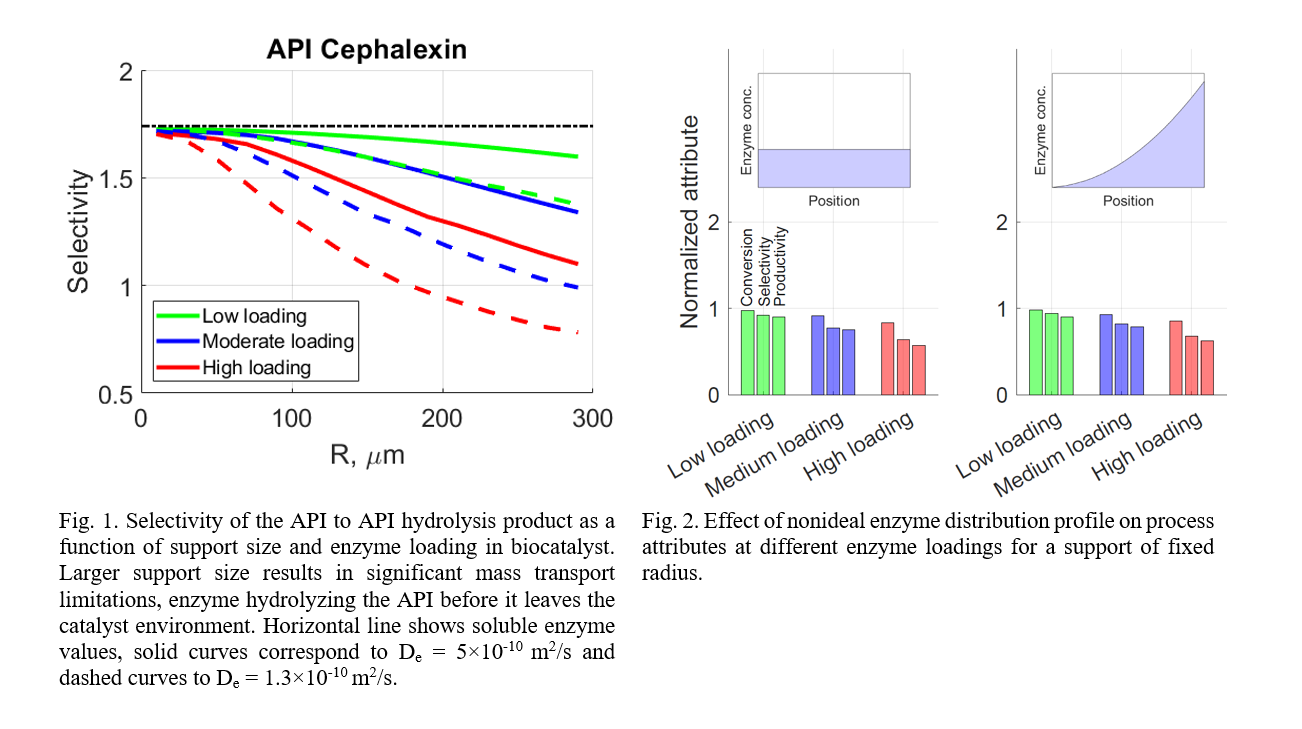The β-lactam antibiotics amoxicillin and cephalexin are among the most widely used antibiotic Active Pharmaceutical Ingredients (API) [1]. Penicillin G Acylase (PGA) can catalyze the reaction between an activated acyl donor (e.g. 4-hydroxyphenylglycine methyl ester) and a nucleophilic molecule containing the β-lactam core (e.g. 6-aminopenicillanic acid) to produce the final antibiotic (e.g. amoxicillin). Similar to many other industrial enzymatic processes, working with immobilized enzyme is essential for downstream separation of the catalyst from the product and retaining the valuable enzyme in continuous manufacturing processes. Working with immobilized enzyme necessitates understanding the effect of transport limitations on the enzyme activity and reaction rate. Moreover, this process meets difficulties such as potentially low conversion and yield due to hydrolysis of the API by the same enzyme such that the desired product is an intermediate in the overall reaction network. One way to improve this process and to protect the antibiotic from being hydrolyzed by the enzyme is isolating it through crystallization. The reactive crystallization also provides process intensification, as a separate downstream crystallization process for purification is no longer required [2].
The complex interplay of three phenomena determine the process attributes: enzyme-catalyzed chemical reaction, species transport into and out of the biocatalyst, and crystallization of the API molecule. In this talk, we will describe our efforts to develop a mathematical model for the enzymatic synthesis of β-lactam antibiotics using immobilized enzyme. The effective diffusion coefficients for two types of commercially available supports (agarose and methacrylic-based beads De=1-5Ã10^-10 m2/s) were measured experimentally and the results were used to describe the effect of pore diffusion on the apparent enzyme activity and reaction rate. Furthermore, coupling the reaction-diffusion module with a crystallization population balance, a mathematical model that encompasses all three phenomena is developed. Application of the formulated model for model-based design and optimization will be discussed. In particular, this approach can aid in design of a biocatalyst to optimize the process attributes of conversion, selectivity, and productivity. To optimize the biocatalyst design into a systematic procedure, three directly controlled variables for biocatalyst are defined: (1) enzyme loading, (2) support type, and (3) support size. The interaction among these factors can be probed using the model for selecting the optimal immobilization condition. As one might expect, using an immobilization support with a radius smaller than a critical value Rc = F(enzyme kinetic, support porosity), selectivity and conversion comparable to that of the soluble enzyme can be achieved (Fig.1). On the other hand, increasing the biocatalyst size above an API-dependent value leads to significant mass transfer limitations and deviation from inherent kinetics. Furthermore, our analysis illustrates that two often neglected nonidealities in the enzyme immobilization procedure, nonuniform enzyme distribution and variance in bead size distribution, may affect the apparent reaction rate and the catalyst performance and cause deviations from targeted operating point (Fig.2).
[1] Giordano, R. C., Ribeiro, M. P., & Giordano, R. L. (2006). Kinetics of β-lactam antibiotics synthesis by penicillin G acylase (PGA) from the viewpoint of the industrial enzymatic reactor optimization. Biotechnology advances, 24(1), 27-41.
[2] McDonald, M. A., Bommarius, A. S., Rousseau, R. W., & Grover, M. A. (2019). Continuous reactive crystallization of β-lactam antibiotics catalyzed by penicillin G acylase. Part I: Model development. Computers & Chemical Engineering, 123, 331-343.

